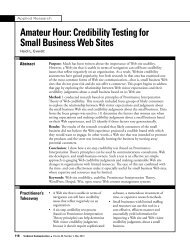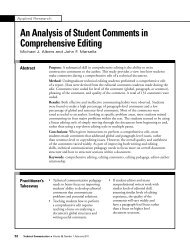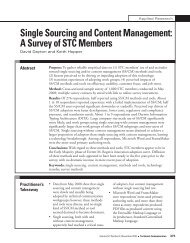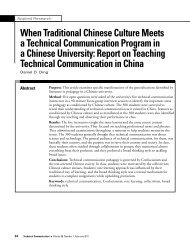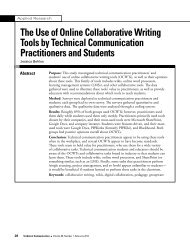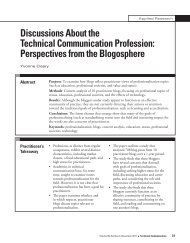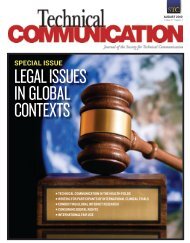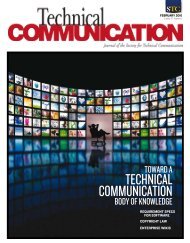SPECIAL ISSUE
Download: November 2011 - Technical Communication - Society for ...
Download: November 2011 - Technical Communication - Society for ...
- No tags were found...
Create successful ePaper yourself
Turn your PDF publications into a flip-book with our unique Google optimized e-Paper software.
Guest EditorialProfessionalization of Technical Communicationvalidation efforts to establish core competencies throughePortfolio review. Supported by a research grant fromthe Council for Programs in Technical and ScientificCommunication (CPTSC), we partnered with facultyof the graduate program in technical communicationat Texas Tech University (TTU) to field test, shareassessment strategies, and work toward a common setof core competencies (Coppola & Elliot, 2007). Thetwo teams were able to find a collaborative set of corecompetencies for our programs, shown as a data point inTable 1 of comparative competencies (Coppola, Elliot,Barker, Carter, & Kimball, 2007). Although small, thispilot project validated our claim that a community ofresearchers could collect localized competency sets thatrespond to their programs’ curricular initiatives andschool missions (Coppola & Elliot, 2010). A currentCPTSC Program Assessment and Review initiative, ledby Thomas Barker, reports outcomes and assessmentmethods of 27 technical communication programs.The CPTSC Outcomes Survey (Barker, 2011) wasadministered to program directors and administratorslisted in the CPTSC academic database to determineprogrammatic outcomes and methods of creating andreviewing outcomes. Their snapshot of sets of programoutcomes provides a data point for Table 1. Eachprogram strives for a desired end: a set of variables that,when taken together, will serve as the core competenciesof our field.If assessment of program outcomes allows evidencebaseddemonstration of professional accomplishmentto the academic stakeholders of our field, how do wedetermine whether our core competencies align withthose of the professional stakeholders? Kenneth Rainey,Roy Turner, and David Dayton (2005) answered thatquestion by surveying 67 technical communicationmanagers to learn which core competencies they seek innew hires. The authors first identified a comprehensivelist of competencies valued by academics throughcontent analysis of 156 course descriptions from the10 top undergraduate programs in technical andprofessional communication in the United States.Dayton’s follow-up interview with three of thesurveyed technical communication managers bothcontextualized and corroborated the survey data. Thecore competencies most important to those who hire ourgraduates are also represented as a data point in Table 1.How do we know that these core competencies aretruly ours? Corporate strategists C. K. Prahalad andGary Hamel (1990) give us four characteristics to test.Core competencies are unique skills that (1) providea significant source of competitive differentiation,(2) transcend a single market, (3) make a significantcontribution to the perceived customer benefits ofthe end product, and (4) are not easily imitated. Theauthors use an elegant metaphor that is as appropriateto technical communication as it is to a corporation:The diversified corporation is a large tree. The trunkand major limbs are core products, the smaller branchesare business units; the leaves, flowers, and fruits are endproducts. The root system that provides nourishment,sustenance, and stability is the core competence. You canmiss the strength of competitors by looking only at theirend products, in the same way you miss the strength ofa tree if you look only at its leaves. (Prahalad & Hamel,1990, p. 82)We are reminded here that our core competenciesare not defined by the end products we produce butby our demonstrable knowledge and skills. And werecognize that technical communication is as muchabout craft knowledge as codified knowledge, often tacitas well as explicit.How might we think about writing, then? Is writingknowledge of the game (a prerequisite to getting intothe casino), or table stakes (capabilities that are crucialfor survival but do not confer any specific differentialadvantage over other competitors in that industry)? Oris writing the casino itself, a core competency that isnot easily imitated anywhere else on the strip? Whenparticularized as writing for a specific audience directedby clearly defined purposes, writing takes its rightfulplace as a core skill for our profession.The newly formed STC Certification Commission(STCC) (STCC Candidate Instructions for STCCertification, 2011) identified broad areas of practicethat represent the major activities performed bytechnical communicators. The committee, led by pastSociety President Michael Hughes, validated theseareas of practice against (1) the new job description oftechnical writing given in the U.S. Bureau of LaborStatistics (BLS) Occupational Outlook Handbook, (2)the International Standards Organization technicalwriting standard (ISO26514), and (3) more than40 help-wanted ads from various locations in the280 Technical Communication l Volume 58, Number 4, November 2011



